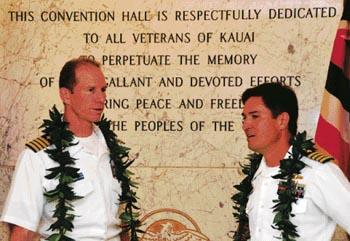LIHU‘E — The U.S. Navy formalized a partnership between its leading independent assessment agent and its premiere ballistic missile defense training range Wednesday at the 6th Annual General Atomics Science Show and Exposition at the Kaua‘i War Memorial Convention Hall.
LIHU‘E — The U.S. Navy formalized a partnership between its leading independent assessment agent and its premiere ballistic missile defense training range Wednesday at the 6th Annual General Atomics Science Show and Exposition at the Kaua‘i War Memorial Convention Hall.
The Naval Surface Warfare Center Corona and the Pacific Missile Range Facility at Mana, both exhibitors and sponsors of the event showcasing math, engineering, science and high technology, signed a Memorandum of Agreement, securing a decades-long collaboration between the two commands to strengthen the Navy’s future Fleet and ballistic missile defense, a core Navy mission and key warfighting capability of the U.S. Maritime Strategy, said Troy Clarke, the Public Affairs Officer for NSWC Corona and also the show’s host.
“We must ensure the Navy continues to meet our many missions of today, while preparing for the unknowable, but inevitably complex challenges of tomorrow,” said Capt. Jay Kadowaki, NSWC Corona commanding officer. “This is one way we provide the support around the globe to our warfighters and to sustain the powerful naval capabilities for our nation.”
PMRF is the world’s largest instrumented multi-environment range capable of supporting surface, subsurface, air and space operations simultaneously. The Kaua‘i facility’s mission is to provide integrated range services in a modern, multi-threat, multi-dimensional environment to ensure safe conduct and evaluation of training, test and evaluation missions. These capabilities improve its customers’ ability to achieve readiness and enable it to meet other national defense objectives.
“Since the closing of the Puerto Rico Training Range, PMRF is the only remaining place with the desired characteristics to conduct testing and evaluation of our complex systems and weapons required to defend our county,” said Capt. Aaron Cudnohufsky, the PMRF commanding officer. “It’s important for the Navy to maintain our vital contribution to our nation’s ballistic missile defense capability. This agreement will help us execute that mission.”
NSWC Corona’s expertise in range systems engineering and instrumentation as well as range laser and directed energy safety has been employed to supplement the workforce at PMRF for the development, integration, and operation of remote sensor systems. In working with PMRF personnel on these and other systems, NSWC Corona has developed expertise in PMRF’s infrastructure, enabling its engineers to provide range systems engineering support to PMRF and to augment its workforce during high manpower-intensive periods.
U.S. Maritime Strategy calls for the nation to project power whenever and wherever required to protect our vital interests, the NSWC Corona release states. Maritime BMD will enhance deterrence by providing an umbrella of protection to forward-deployed forces and to defend against established and emergent threats.
The complex engineering challenges to deliver a direct hit with a ballistic missile is likened to hitting a bullet with a bullet, when closing in on the target at effectively, thousands of miles per hour. When the missile collides with its target, it is vaporized by kinetic energy, one of the concepts demonstrated at the General Atomics Science Show.
“NSWC Corona’s expertise in range instrumentation and performance assessment of missile and combat systems gives us unique capability to support PMRF,” said Kadowaki. “We are very proud of this partnership and eager to support the ballistic missile defense of today, and the even more sophisticated capability of tomorrow. This agreement helps us do just that.”
• Dennis Fujimoto, photographer and staff writer, can be reached at 245-3681 (ext. 253) or dfujimoto@kauaipubco.com.


